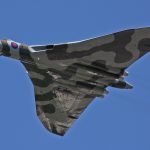
(Photo by ©Trustees of the Royal Air Force Museum’)
PRESS RELEASE – The Royal Air Force Museum Cosford is pleased to announce that its latest acquisition, VC10 serial number XR808 has now arrived at Cosford, following a final road trip along the M6 motorway. After a successful eight month dismantling process carried out by GJD Services, a specialist maintenance and aircraft salvage company based at Bruntingthorpe, Leicestershire, the VC10 finally arrived at Cosford on Sunday 21 June. The 93ft long fuselage departed from Bruntingthorpe early on the Sunday morning and arrived at Cosford shortly after 1.00pm. Transported on a low loader lorry, the route saw the aircraft pass along the M69, M6 and the M54 to Cosford, via the nearby village of Shifnal. Too large to pass under the railway bridge at Cosford, the fuselage made its way to Junction 4 on the M54 and through Shifnal, with some tricky manoeuvring en route, before heading onto the airfield at RAF Cosford.
Sqn Ldr Chris Wilson, Media, Communication and Co-ordination Officer at RAF Cosford said:“Having flown on VC10s throughout my career I’ve been looking forward to seeing this one arrive at RAF Cosford. The VC10 has been an iconic RAF aircraft for so many decades that it seems fitting that XR808 finally comes to rest at the RAF Museum at the end of its exemplary service. RAF Cosford is the Home of RAF Engineering so it is apt that the VC10 comes to our airfield to be rebuilt prior to going on permanent display at the Museum.”The VC10 wings and tail plane will be transported on 28 June and work will then commence on the rebuild. Throughout July a team of engineers from GJD Services will unload the aircraft, position and trestle the inner wings before attaching them to the fuselage. Early August the aircraft will transfer from the RAF Cosford airfield to the Museum site for the final reassembly, which will take place directly outside the Museum’s Hangar 1.
Once on the Museum’s site, the wings will be rebuilt and the rear fuselage section attached. By late September the team anticipates to be fitting the fin and tail plane ready to install the engines, nacelles and outer wings. The final finishing touches of refitting the access panels and a little paint work touch up will be carried out late October before the fully reassembled VC10 is moved into its final position next to the Lockheed Hercules C130K Mk3, where the aircraft will go on public display.
Gary Spoors, Accountable/Engineering Manager at GJD Services said:“When GJD were asked to move XR808 on behalf of the RAF Museum we were very keen to take on the challenge; to play our part in preserving this icon of British Engineering. Whist we were fully aware of the scope of the challenge presented to us, it has tested our engineering skills. Working as a team we have come up with some innovative solutions to problems as they arose, all of which we have overcome. Personally, I have a great affiliation with the VC10, having worked on the type throughout various stages of my career and I wanted to ensure that XR808 was dismantled and moved with care and precision. We chose to reverse engineer the aircraft, de-riveting the various section, wing, fin, tail and back end, in order to avoid any cuts which we felt would compromise the integrity and beauty of the aircraft. An enormous effort has gone into the dismantling of XR808 and we are very pleased with progress the GJD team has made so far. We are looking forward to the next phase and seeing XR808 complete in her new home.”
The VC10 was a British aircraft originally built by Vickers-Armstrong and then later by the British Aircraft Corporation and entered service with Royal Air Force in 1966. This dual-role aircraft enabled the rapid deployment of troops and their weaponry and fast jet aircraft to many theatres of operations around the world. With the ability to carry up to 124 troops at a time with nine crew members or a freight load of up to 20,400kgs the VC10 has been one of the RAF’s most significant assets for nearly 50 years. The RAF VC10’s allowed true global mobility offering a combination of speed and range never previously attained by an RAF Transport Command aircraft type.
Ian Thirsk, Head of Collections at the RAF Museum said: “The BAC VC-10 formed the mainstay of the RAF’s long range strategic transport force for almost fifty years. For one aircraft type to have been in service for such a long period is remarkable in itself. However, when this is added to the variety of roles and worldwide scope of operations, it is clear this is a unique aircraft and it would not be possible to accurately portray the history of the RAF without an example of the type – therefore it is essential that such a pivotal and long serving aircraft is preserved by the RAF Museum.”
Darren Priday, Conservation Centre Manager at the RAF Museum said: “I completed two tours on VC10’s during my RAF career, totalling 6½ years on type, so I am looking forward to being reacquainted with an old friend. Renown for being a troop carrier the VC10 also excelled in other roles – carrying freight, aero-med, VIP duties and air-to-air refuelling. ‘BOB’, will be a great addition to the RAF Museum Cosford site.”
For further information about the Museum, please visit the Museum website www.rafmuseum.org or call 01902 376200. The Museum is open daily from 10am and entry to the Museum is FREE of charge.






























